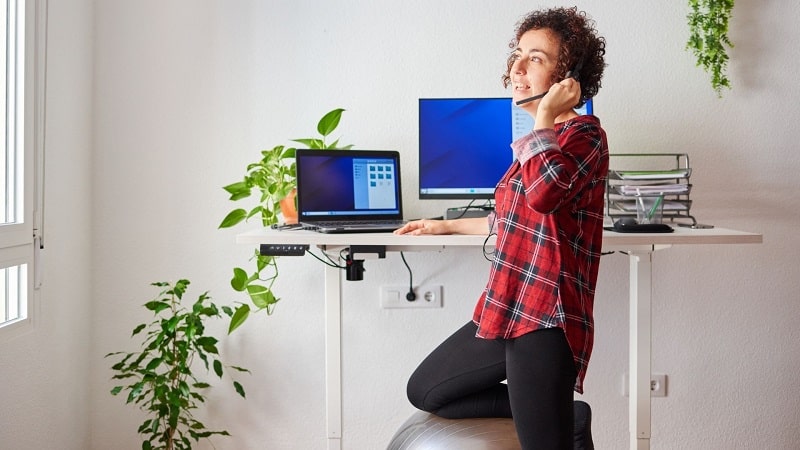We’ve all heard horror stories about the risks of sitting at your desk all day long.
If you’ve experienced sharp neck pain every time you get up from your chair at the end of the day, you’re already familiar with the health issues that come with sitting.
Of course, you can always use ergonomic chairs and cushions to alleviate your aches and pains, but what if there’s a better way?
This is where a standing desk comes into play.
With all the hype surrounding standing desks, however, you’re bound to wonder: Do they really work? Is a standing desk the cure-all for weight gain and productivity?
Standing desks are known to offer a host of health benefits as they reduce the amount of time you spend sitting. This, in turn, can not only help prevent weight issues but also alleviate back and neck pain.
In this article, we’ll answer all your queries about standing desks and more.
Read on to learn how a standing desk can affect neck pain.
Table of Contents
What Is a Standing Desk?
A standing desk is a desk that you can work at while standing.

These desks may be height-adjustable or have a fixed height that allows you to keep your computer at eye level while standing.
They are also known as height-adjustable desks, sit-stand desks, or stand-up desks.
The main purpose of a standing desk is to provide a healthier alternative to sitting in chairs for long periods.
Is Standing Better for Neck Pain?
Yes.
Neck pain is the result of poor posture, muscle strain, and fatigue caused by overused muscles.

Sitting at the desk for a long duration is known to increase strain in the neck, back, and shoulders.
Prolonged sitting can tighten your back muscles, including the muscles in your neck, and ultimately lead to postural strain.
Postural strain is the strain that you put on your body when you support a wrong posture for a long duration. The strain weakens your muscles, which in return become stiff and tense.
This means, the more you work, the more fatigued your muscles become, resulting in sharp pains, aches, and headaches.
In contrast, when you stand, your body has the following set of reactions:
- Better positioning of the pelvis
- Stronger core
- Better spinal alignment
- Improved blood circulation
- Improved oxygen flow

When you stand, your body weight is more evenly distributed compared to when you’re sitting. If you take into account the weight of your head alone, you’re already carrying 3 pounds.
On the other hand, when you sit, most of the weight of your head is distributed unevenly across the upper body. This creates excess pressure on your back, shoulder, and neck muscles.
Standing can reduce the strain on your neck.
Hence, standing is better than sitting for relieving neck pain.
Does a Standing Desk Help Your Neck Pain?
Yes. Standing desks are a great alternative to sitting in a chair for long durations.
By allowing you to stand more often and for longer intervals, standing desks can help relieve and prevent neck pain. Standing at a desk is an easy way to distribute your body weight evenly while working.

Standing also promotes better spinal alignment and posture. Thus, improving the quality of movements your body makes.
Apart from this, standing desks encourage you to stand more often as you work and take more breaks.
This allows you to schedule your work so that you can take enough breaks to step away from your computer. That is why it is a great way to reduce physical stress on the neck.
Let’s take a look at the important physical as well as mental factors affected by standing desks.
Weight Gain
A number of studies have proven that prolonged sitting is associated with weight gain.
But does standing up make any difference?
Well, yes. Studies have shown that standing does have a positive impact on the prevention of weight gain.

By standing up at your desk, you could reduce 0.15 kcal more per minute than when you’re sitting.
That’s 5.5 pounds lost within one year. All by simply ditching the office chair!
If you’re trying to shed a few pounds, standing can be a more effective option than sitting.
Productivity
Standing improves the posture of your body in comparison to when you’re sitting. And a good posture allows your biological processes to occur naturally.

Of these biological processes, blood circulation and oxygen distribution are two of the most crucial that improve when you’re standing. An increase in blood and oxygen distribution in the body is known to help improve productivity and awaken the brain.
Thus, productivity does increase when you’re standing compared to when you’re sitting at a desk all day.
How Should I Stand at a Standing Desk With My Neck Pain?
If you’re not too familiar with the appropriate standing, sitting, and walking postures to maximize proper alignment, you’re like most of us.
There’s more to standing than what we’ve learned.
Since a standing desk is used mainly for work, this guide will focus on posture tips when working. Here’s a brief yet comprehensive guide on the right way to stand at a standing desk when you have neck pain.
1. Take Frequent Breaks From Standing
Just like long periods of sitting, long periods of standing can also put a lot of pressure on your joints and feet.
This can result in leg cramps, muscle fatigue, joint compression, and backaches. It can also put you at a greater risk of plantar fasciitis, varicose veins, and arthritis.

The best way to prevent this is to balance both sitting and standing on an hour-by-hour rotation. You can choose to alternate sitting at the desk and standing in 1–2 hour periods.
If you have only recently started using a standing desk, then you might cope better by standing for 30 minutes at first.
Take frequent breaks to sit and increase your standing time as you get more comfortable.
2. Adjust the Desk Height
Make sure that the height of your desk matches the height of your elbow. The desk should rest right below your elbow level.
Your elbows should be bent at a 90-degree angle with your wrists relaxed over the desk’s surface to ensure better posture.
3. Pay Attention to the Alignment of Your Body
When standing at the desk, make sure to keep your head, neck, and spine in a straight line to prevent uneven weight distribution and soreness.
The lower half of your body also needs to be in alignment.

To get the best out of your standing position, keep your legs and feet parallel. Position your feet directly under your body with the feet shoulder-length apart.
Distribute your weight to the balls of your feet. Align your kneecaps and bend your knees a little so that the blood flows normally to your feet.
Another often-ignored area that you must be more aware of is the wrist.
The wrist position needs to be adjusted differently when you’re standing than when you’re sitting. The right position for the wrists when standing at a desk is upwards, tilted at a slight angle.
4. Adjust Your Computer Screen
The distance between your eyes and the screen should be 20–28 inches, with the top of the screen at your eye level.
This gives your neck a tilt when looking at the screen and reduces excess strain in the neck and shoulder muscles.
The monitor should also be tilted upwards at a 10- to 20-degree angle.
5. Choose the Right Shoes
The right pair of footwear is not only important for running and walking but can also greatly reduce the strain on your feet even when you are simply standing.

When standing for long periods at length, opt for shoes with small or no heels. High-heeled shoes are known to increase the pressure in the forefoot.
Choose shoes with arch support, a firm grip, and enough space to move your toes.
6. Try Anti-Fatigue Mats and Cushions
Anti-fatigue mats and standing cushions are popular products to go along with your standing desk.

These mats and cushions help promote blood circulation to all parts of the feet by encouraging the movement of leg muscles.
They are made to provide optimum comfort to the person standing at a desk, counter, or product line.
In Conclusion: Is a Standing Desk an Effective Solution for Neck Pain?
The activity of standing itself has many benefits. And these benefits you can avail of by simply standing up at your desk.
Standing desks are a great way to relieve pain in the neck, back, and shoulders.
Not only does a standing desk resolve existing aches, it also keeps your body from accumulating postural stress.
Standing at your desk can also help you be more productive at work and keep you from putting on those extra pounds!
However, while a standing desk does take away most of your postural stress, it doesn’t come without guidelines. Working at a standing desk and ensuring you’re maintaining the right posture does the trick perfectly.
With a standing desk, you too can say goodbye to your neck pain!

My name is Vance, and I am the owner of To Ergonomics. Our mission is to improve your workflow by helping you create a supportive and welcoming environment. We hope that you’ll find what you’re looking for while you’re here.

